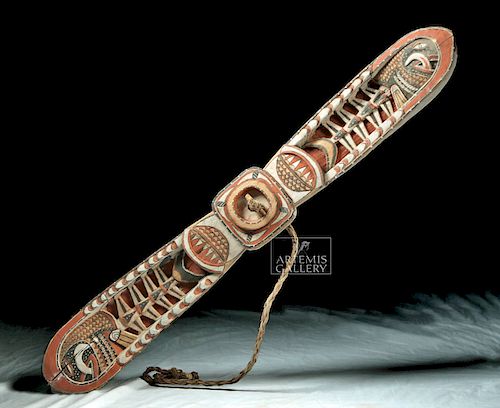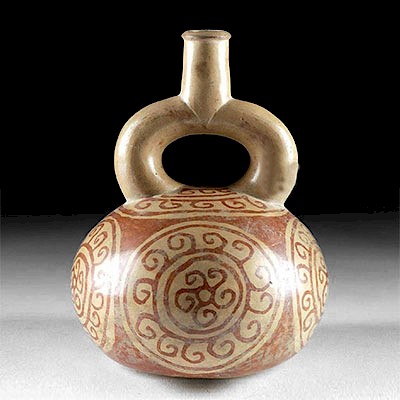20th C. Papua New Guinea Painted Wood Shark Propeller
Lot 139a
About Seller
Artemis Fine Arts
686 S Taylor Ave, Ste 106
Louisville, CO 80027
United States
Selling antiquities, ancient and ethnographic art online since 1993, Artemis Gallery specializes in Classical Antiquities (Egyptian, Greek, Roman, Near Eastern), Asian, Pre-Columbian, African / Tribal / Oceanographic art. Our extensive inventory includes pottery, stone, metal, wood, glass and textil...Read more
Estimate:
$1,200 - $1,700
Absentee vs Live bid
Two ways to bid:
- Leave a max absentee bid and the platform will bid on your behalf up to your maximum bid during the live auction.
- Bid live during the auction and your bids will be submitted real-time to the auctioneer.
Bid Increments
| Price | Bid Increment |
|---|---|
| $0 | $25 |
| $300 | $50 |
| $1,000 | $100 |
| $2,000 | $250 |
| $5,000 | $500 |
| $10,000 | $1,000 |
| $20,000 | $2,500 |
| $50,000 | $5,000 |
| $100,000 | $10,000 |
| $200,000 | $20,000 |
About Auction
By Artemis Fine Arts
Jan 24, 2019
Set Reminder
2019-01-24 10:00:00
2019-01-24 10:00:00
America/New_York
Bidsquare
Bidsquare : Pre-Columbian / Ethnographic Art
https://www.bidsquare.com/auctions/artemis-gallery/pre-columbian-ethnographic-art-3814
Featuring ancient and ethnographic art from around the world, including Pre-Columbian, Native American, African / Tribal, Ethnographic, Spanish Colonial, Fossils, Fine Art, much more. Artemis Fine Arts info@artemisfinearts.com
Featuring ancient and ethnographic art from around the world, including Pre-Columbian, Native American, African / Tribal, Ethnographic, Spanish Colonial, Fossils, Fine Art, much more. Artemis Fine Arts info@artemisfinearts.com
- Lot Description
Oceania, Papua New Guinea, ca. first half of the 20th century CE. A hand-carved wooden propeller with a square central body, a pair of curved fin bases, and two lengthy fins with openwork grooves and curved terminals. Each fin terminal boasts a stylized shark head in low relief, each with curving fangs, triangular scales, and incised gills, and the animals' skeletal bodies are displayed within the recessed fin bodies. The intricate details of the obverse side are brought forth with applied orange-red, white, yellow, and black pigment, and the verso is lightly covered in white pigment. A carved hole in the central body houses a long cord formed from braided reeds. Size: 6.75" W x 48.75" H (17.1 cm x 123.8 cm).
Shark propellers like this example are an intriguing tool which provide insight into how indigenous peoples are able to successfully hunt sharks. According to the Australian National Maritime Museum, "The propeller is traditionally used in a Papua New Guinean shark magic ceremony. In a narrow outrigger canoe, a man who has prepared for the ceremony softly 'calls' the sharks by thumping the water with his paddle. He then shakes the larung or 'shark rattle' in the water, which attracts the shark to the surface. The shark would swim through the loop [of the rope] which was tightened around its tail, the drag would tire the shark out allowing it to be caught and killed." (http://collections.anmm.gov.au/en/objects/164737/papua-new-guinean-shark-propeller-used-by-ron-and-valerie-ta;jsessionid=626C9C0BBE0D28CFA5735BFCB1EF0CF8?ctx=d89fbada-32fc-4024-b9d2-2db453d79f64&idx=1421)
For a stylistically-similar example of a shark propeller without pigmentation or carved zoomorphic motifs, please see the Australian National maritime Museum, object number 00050006: http://collections.anmm.gov.au/en/objects/164737/papua-new-guinean-shark-propeller-used-by-ron-and-valerie-ta;jsessionid=626C9C0BBE0D28CFA5735BFCB1EF0CF8?ctx=d89fbada-32fc-4024-b9d2-2db453d79f64&idx=1421
Provenance: private Southern California, USA collection, acquired in the 1970s to mid-1980s
All items legal to buy/sell under U.S. Statute covering cultural patrimony Code 2600, CHAPTER 14, and are guaranteed to be as described or your money back.
A Certificate of Authenticity will accompany all winning bids.
We ship worldwide and handle all shipping in-house for your convenience.
#141702Losses to some carved areas, a few stable fissures on fins and central body, softening to some finer details, and fading to applied pigmentation. Light earthen deposits and nice patina throughout.Condition
- Shipping Info
-
All shipping is handled in-house for your convenience. Your invoice from Artemis Gallery will include shipping calculation instructions. If in doubt, please inquire BEFORE bidding for estimated shipping costs for individual items.
-
- Buyer's Premium



 EUR
EUR CAD
CAD AUD
AUD GBP
GBP MXN
MXN HKD
HKD CNY
CNY MYR
MYR SEK
SEK SGD
SGD CHF
CHF THB
THB















